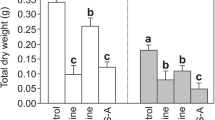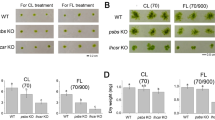Abstract
Strontium (Sr2+) pollution and its biological effects are of great concern including photosynthetic regulation, which is fundamental to environmental responses, especially for bryophytes during their terrestrial adaptation. Alternative electron flows mediated by flavodiiron proteins (FLVs) and cyclic electron flow (CEF) in photosystem I (PSI) are crucial to abiotic stresses moss responses; however, little is known about the moss photosynthesis regulation under nuclide treatment. We measured chlorophyll fluorescence parameters in PSI, photosystem II (PSII) and the P700 redox state, oxidative stress in the moss Racomitrium japonicum under low (5 mg/L), moderate (50 mg/L) and high (500 mg/L) Sr2+ stress level. Moderate and high Sr2+ stress triggered H2O2 and malondialdehyde (MDA) generation, and catalase (CAT) activity increases, which are involved in reactive oxygen species regulation. The significant PSII photochemistry (Fv/Fm), Chla/chlb, Y(I)/Y(II), Y(NA), Y(ND) and ETRI-ETRII decreases at moderate and high Sr2+, and the Y(I), Y(II) decreases at high Sr2+ revealed the photo-inhibition and photo-damage in PSI and PSII by moderate and high Sr2+ stress. The nonphotochemical quenching (NPQ) increased significantly at moderate and high Sr2+ stress, reflecting a heat-dissipation-related photo-protective mechanism in antenna system and reaction centers. Moreover, rapid re-oxidation of P700 indicated that FLV-dependent flows significantly regulated PSI redox state under moderate and high Sr2+ stress. and CEF upregulation was found at low Sr2+. Finally, photosynthetic acclimation to Sr2+ stress in R. japonicum was linked to FLVs and CEF adjustments.








Similar content being viewed by others
Data availability
The datasets analyzed during this study are available from the corresponding author.
References
Alboresi A, Storti M, Morosinotto T (2019) Balancing protection and efficiency in the regulation of photosynthetic electron transport across plant evolution. New Phytol 221(1):105–109
Brestic M, Zivcak M, Kunderlikova K, Allakhverdiev SI (2016) High temperature specifically affects the photoprotective responses of chlorophyll b-deficient wheat mutant lines. Photosynth Res 130(1):251–266
Brestic M, Zivcak M, Kunderlikova K, Sytar O, Shao H, Kalaji HM, Allakhverdiev SI (2015) Low PSI content limits the photoprotection of PSI and PSII in early growth stages of chlorophyll b-deficient wheat mutant lines. Photosynth Res 125(1):151–166
Burger A, Weidinger M, Adlassnig W, Puschenreiter M, Lichtscheidl I (2019) Response of Plantago major to cesium and strontium in hydroponics: absorption and effects on morphology, physiology and photosynthesis. Environ Pollut 254:113084
Chen Y-E (2007) Determination of heavy metal content in bryophytes and effects of heavy metal stress on physiological indexes of bryophytes. Doctoral dissertation of Sichuan University, Chengdu
Cheng X, Chen C, Hu Y, Guo X, Wang J (2022a) Photosynthesis and growth of Amaranthus tricolor under strontium stress. Chemosphere 308:136234
Cheng X, Chen C, Hu Y, Wang J (2022b) Response of Amaranthus tricolor to cesium stress in hydroponic system: growth, photosynthesis and cesium accumulation. Chemosphere 307:135754
Choppin G (2007) Actinide speciation in the environment. J Radioanal Nucl Chem 273(3):695–703
Dawson S, Dennison W (1996) Effects of ultraviolet and photosynthetically active radiation on five seagrass species. Mar Biol 125(4):629–638
Dhindsa RS, Plumb-Dhindsa P, Thorpe TA (1981) Leaf senescence: correlated with increased levels of membrane permeability and lipid peroxidation, and decreased levels of superoxide dismutase and catalase. J Exp Bot 32(1):93–101
Harbinson J, Foyer CH (1991) Relationships between the efficiencies of photosystems I and II and stromal redox state in CO2-free air: evidence for cyclic electron flow in vivo. Plant Physiol 97(1):41–49
Hendrickson L, Furbank RT, Chow WS (2004) A simple alternative approach to assessing the fate of absorbed light energy using chlorophyll fluorescence. Photosynth Res 82(1):73–81
Huang W (2012) Cycle electron transport plays an important role in plant resistance to environmental stress. University of Science and Technology of China, Hefei
Huang W, Yang Y-J, Zhang S-B (2019a) Photoinhibition of photosystem I under fluctuating light is linked to the insufficient ΔpH upon a sudden transition from low to high light. Environ Exp Bot 160:112–119
Huang W, Yang Y-J, Zhang S-B (2019b) The role of water-water cycle in regulating the redox state of photosystem I under fluctuating light. Biochimica et Biophysica Acta (BBA)-Bioenergetics 1860 (5):383–390
Kong F, Liu X-Y, Wang G-Z, Zhang K (2016) Effects of fertilizer dosage on photosynthesis and fast chlorophyll fluorescence characteristics of Juglans regia in mountainous region. For Res 29(5):764
Kramer DM, Johnson G, Kiirats O, Edwards GE (2004) New fluorescence parameters for the determination of QA redox state and excitation energy fluxes. Photosynth Res 79(2):209–218
Lai J-l, Luo X-g (2019) High-efficiency antioxidant system, chelating system and stress-responsive genes enhance tolerance to cesium ionotoxicity in Indian mustard (Brassica juncea L.). Ecotoxicol Environ Saf 181:491–498
Li C, Wang M, Luo X, Liang L, Han X, Lin X (2019) Accumulation and effects of uranium on aquatic macrophyte Nymphaea tetragona Georgi: potential application to phytoremediation and environmental monitoring. J Environ Radioact 198:43–49
Li H, Tang Y-J, Zeng F (2013) Effects of high concentration Strontium and Cesium stress on chlorophyll fluorescence characteristics of plants. Jiangsu Agri Sci 41(9):349–352
Li Z, Wakao S, Fischer BB, Niyogi KK (2009) Sensing and responding to excess light. Annu Rev Plant Biol 60:239–260
Lu K-S (2008) Effects of salt stress on photosynthesis and antioxidant system of Soybean and its regulatory mechanism. Hangzhou: Doctoral dissertation of Zhejiang University
Luo H-Y, Gao H-B, Xia Q-P, Gong B-B, Wu X-L (2011) Effects of γ -aminobutyric acid on reactive oxygen metabolism and chlorophyll fluorescence parameters of tomato under salt stress. J Integr Agric 44(4):753–761
Lv Q-P, Chng X-A (2020) To study the changes of hydrogen peroxide and polyphenol oxidase in Prunus eurysolis under waterlogging stress. J Fruit Resour 1(1):1–5
Maksimovic I, Kastori R, Putnik-Delic M, Borišev M (2014) Effect of yttrium on photosynthesis and water relations in young maize plants. J Rare Earths 32(4):372–378
Marešová J, Pipíška M, Rozložník M, Horník M, Remenárová L, Augustín J (2011) Cobalt and strontium sorption by moss biosorbent: modeling of single and binary metal systems. Desalination 266(1–3):134–141
Meng X-L (2013) Photodamage defense mediated by mitochondrial alternation oxidase pathway in Cucumber leaves under different light and temperature conditions. Doctoral dissertation of Shandong Agricultural University, Taian
Miyake C, Miyata M, Shinzaki Y, Tomizawa K-i (2005) CO2 response of cyclic electron flow around PSI (CEF-PSI) in tobacco leaves—relative electron fluxes through PSI and PSII determine the magnitude of non-photochemical quenching (NPQ) of Chl fluorescence. Plant Cell Physiol 46(4):629–637
Nicol L, Nawrocki WJ, Croce R (2019) Disentangling the sites of non-photochemical quenching in vascular plants. Nature Plants 5(11):1177–1183
Paatero J, Jaakkola T, Kulmala S (1998) Lichen (sp. Cladonia) as a deposition indicator for transuranium elements investigated with the Chernobyl fallout. J Environ Radioact 38(2):223–247
Shikanai T, Yamamoto H (2017) Contribution of cyclic and pseudo-cyclic electron transport to the formation of proton motive force in chloroplasts. Mol Plant 10(1):20–29
Shimakawa G, Miyake C (2019) What quantity of photosystem I is optimum for safe photosynthesis? Plant Physiol 179(4):1479–1485
Storti M, Alboresi A, Gerotto C, Aro EM, Finazzi G, Morosinotto T (2019) Role of cyclic and pseudo-cyclic electron transport in response to dynamic light changes in Physcomitrella patens. Plant Cell Environ 42(5):1590–1602
Strand DD, Livingston AK, Satoh-Cruz M, Froehlich JE, Maurino VG, Kramer DM (2015) Activation of cyclic electron flow by hydrogen peroxide in vivo. Proc Natl Acad Sci 112(17):5539–5544
Sun H, Yang Y-J (1861) Huang W (2020) The water-water cycle is more effective in regulating redox state of photosystem I under fluctuating light than cyclic electron transport. Biochim Biophys Acta (BBA)-Bioenerg 9:148235
Takagi D, Takumi S, Hashiguchi M, Sejima T, Miyake C (2016) Superoxide and singlet oxygen produced within the thylakoid membranes both cause photosystem I photoinhibition. Plant Physiol 171(3):1626–1634
Tan S-L, Huang J-L, Zhang F-P, Zhang S-B, Huang W (2021) Photosystem I photoinhibition induced by fluctuating light depends on background low light irradiance. Environ Exp Bot 181:104298
Tan S-L, Liu T, Zhang S-B, Huang W (2020a) Balancing light use efficiency and photoprotection in tobacco leaves grown at different light regimes. Environ Exp Bot 175:104046
Tan S-L, Yang Y-J, Huang W (2020b) Moderate heat stress accelerates photoinhibition of photosystem I under fluctuating light in tobacco young leaves. Photosynth Res 144(3):373–382
Tikkanen M, Mekala NR (1837) Aro E-M (2014) Photosystem II photoinhibition-repair cycle protects Photosystem I from irreversible damage. Biochim Biophys Acta (BBA)-Bioenerg 1:210–215
Walker BJ, Strand DD, Kramer DM, Cousins AB (2014) The response of cyclic electron flow around photosystem I to changes in photorespiration and nitrate assimilation. Plant Physiol 165(1):453–462
Wang X, Chen C, Wang J (2017) Phytoremediation of strontium contaminated soil by Sorghum bicolor (L.) Moench and soil microbial community-level physiological profiles (CLPPs). Environ Sci Pollut Res 24(8):7668–7678
Yamamoto H, Shikanai T (2019) PGR5-dependent cyclic electron flow protects photosystem I under fluctuating light at donor and acceptor sides. Plant Physiol 179(2):588–600
Yamamoto H, Takahashi S, Badger MR, Shikanai T (2016) Artificial remodelling of alternative electron flow by flavodiiron proteins in Arabidopsis. Nat Plants 2(3):1–7
Yamori W, Makino A, Shikanai T (2016) A physiological role of cyclic electron transport around photosystem I in sustaining photosynthesis under fluctuating light in rice. Sci Rep 6(1):1–12
Yang Y-J, Ding X-X, Huang W (2019) Stimulation of cyclic electron flow around photosystem I upon a sudden transition from low to high light in two angiosperms Arabidopsis thaliana and Bletilla striata. Plant Sci 287:110166
Zhang, G-F, Duan, Z-Z, Luo, X-J, Su, W-H (2011) Chlorophyll fluorescence characteristics and tolerance of two mosses in response to Pb2+ concentration. Environ Pollut Cont 1:36–40
Zhang X-L, Wang P-C, Song C-P (2009) Method for determination of hydrogen peroxide in plant cells. Journal of Plant 44(01):103
Zhou D-D, Liu D-X, Li C-H, Chen M-M, Liu G-M, Yang Q-S, Li Y-T (2016) Photosynthetic characteristics and chlorophyll fluorescence parameters of Celtis sinensis and Ulmus pumila L. seedling under salt stress. Acta Bot Boreali-Ocidentalla Sin 36(5):1004–1011
Zivcak M, Brestic M, Kunderlikova K, Sytar O, Allakhverdiev SI (2015) Repetitive light pulse-induced photoinhibition of photosystem I severely affects CO2 assimilation and photoprotection in wheat leaves. Photosynth Res 126(2):449–463
Funding
This work was supported by the National Key Research and Development Program of China (2020YFE0203200), the Open Fund Program of the CAS Key Laboratory of Mountain Ecological Restoration and Bioresource Utilization and Ecological Restoration and Biodiversity Conservation Key Laboratory of Sichuan Province, Chengdu Institute of Biology, Chinese Academy of Sciences (KXYSWS2204), Sichuan Science and Technology Department Program (2020YFS0344, 2022YFS0492, 2021YFH0008, 2022YFH0040) and the Opening Project of Hubei Engineering Research Center for Specialty Flowers Biological Breeding (2022ZD003).
Author information
Authors and Affiliations
Contributions
All authors contributed to the study conception and design. KC, RHH and YBL conceived and designed research. HR and YHL conducted experiments. RHH, WTL, LLZ and HR analyzed data. HR, KC and YBL wrote the first draft of the manuscript and intensively edited by all authors.
Corresponding author
Ethics declarations
Ethics approval
This article does not contain any studies with human participants or animals performed by any of the authors.
Consent for publication
All authors whose names appear on the submission approved the version to be published and agree to be accountable for all aspects of the work in ensuring that questions related to the accuracy or integrity of any part of the work are appropriately investigated and resolved.
Conflict of interest
The authors declare no competing interests.
Additional information
Responsible Editor: Gangrong Shi
Publisher's note
Springer Nature remains neutral with regard to jurisdictional claims in published maps and institutional affiliations.
Rights and permissions
Springer Nature or its licensor (e.g. a society or other partner) holds exclusive rights to this article under a publishing agreement with the author(s) or other rightsholder(s); author self-archiving of the accepted manuscript version of this article is solely governed by the terms of such publishing agreement and applicable law.
About this article
Cite this article
Ren, H., Huang, R., Li, Y. et al. Photosynthetic regulation in response to strontium stress in moss Racomitrium japonicum L. Environ Sci Pollut Res 30, 20923–20933 (2023). https://doi.org/10.1007/s11356-022-23684-4
Received:
Accepted:
Published:
Issue Date:
DOI: https://doi.org/10.1007/s11356-022-23684-4




